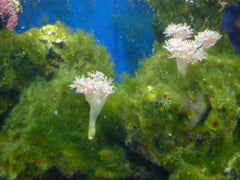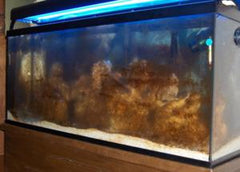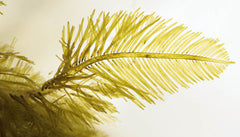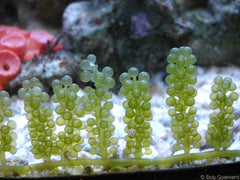How to Identify and Treat Unwanted Nuisance Algae
Unwanted algae in the reef tank can become a real nuisance if left untreated. It can over run large portions of your tank, killing coral and making your reef life miserable. The best way to treat unwanted algae is to identify it and treat it before it gets out of control. Here's a list of the most common unwanted algae in the reef aquarium along with some tips on how to treat it.
Red Slime Algae (aka Cyanobacteria):
 This bacteria is not an algae, however it has taken on the nickname of "Red Slime Algae" as it is commonly referred to. Red Slime algae is a maroon colored film that typically lies on a sand bed or on live rock. It can be treated with a combination of Red Slime Algae Treatments, increased water flow, decreased photo-period, manual removal and water changes. More info is available in this article.
This bacteria is not an algae, however it has taken on the nickname of "Red Slime Algae" as it is commonly referred to. Red Slime algae is a maroon colored film that typically lies on a sand bed or on live rock. It can be treated with a combination of Red Slime Algae Treatments, increased water flow, decreased photo-period, manual removal and water changes. More info is available in this article.
Green Hair Algae:
Diatoms: This is a fine brown film that covers the inside of your tank and is very common when tanks are cycling, or when new live rock or sand is introduced. These are a result of high silicates. A silicate reducing filtration media can be used to control diatoms long term. Immediate removal is easy, just use an aquarium scraper. Long term treatment should be handled by Cerith Snails.
This is a fine brown film that covers the inside of your tank and is very common when tanks are cycling, or when new live rock or sand is introduced. These are a result of high silicates. A silicate reducing filtration media can be used to control diatoms long term. Immediate removal is easy, just use an aquarium scraper. Long term treatment should be handled by Cerith Snails.
Bryopsis: This is a branching green algae that has a mat like root system on the rocks and sand bed. Bryopsis can be a very tenacious algae that is difficult to treat. While some clean up crew will eat it, they most likely will not completely remove it. Try to treat it quickly before it gets out of control. Remove rocks with bryopsis and place in a QT tank with little or no light. In the main tank, reduce excess nutrients, and treat with Brightwell HydratMG, a magnesium treatment.
This is a branching green algae that has a mat like root system on the rocks and sand bed. Bryopsis can be a very tenacious algae that is difficult to treat. While some clean up crew will eat it, they most likely will not completely remove it. Try to treat it quickly before it gets out of control. Remove rocks with bryopsis and place in a QT tank with little or no light. In the main tank, reduce excess nutrients, and treat with Brightwell HydratMG, a magnesium treatment.
Valonia: Also known as Bubble Algae, this algae typically is introduced to your tank through live rock or coral frags. Thorough inspection of incoming pieces is recommended. Removal requires a small pipette or siphon, and a thin razor or scraper. Try to dislodge the valonia from the rock without puncturing the bubble. When free, siphon it off and dispose of it. Repeat over and over until it is gone, then perform a water change. Small Emerald Crabs will eat Valonia.
Also known as Bubble Algae, this algae typically is introduced to your tank through live rock or coral frags. Thorough inspection of incoming pieces is recommended. Removal requires a small pipette or siphon, and a thin razor or scraper. Try to dislodge the valonia from the rock without puncturing the bubble. When free, siphon it off and dispose of it. Repeat over and over until it is gone, then perform a water change. Small Emerald Crabs will eat Valonia.
Dinoflagellates: This algae looks like a beige snot with air bubbles trapped under and within it. Dinos are typically a result of high nutrients. Manual removal is required for immediate treatment. Long term treatment requires protein skimming and use of a Phosban Reactor.
This algae looks like a beige snot with air bubbles trapped under and within it. Dinos are typically a result of high nutrients. Manual removal is required for immediate treatment. Long term treatment requires protein skimming and use of a Phosban Reactor.
Caulerpa: Also known as Grape Algae because it looks like tiny green grapes growing on a vine. Do not let it's cute looks fool you, this stuff is highly invasive and can be lethal to entire ecosystems. Manual removal is required, use a dental pick to remove the runner base that the stems radiate from. Can also be controlled by Emerald Crabs, Sea Hares, Tangs, Angels, Urchins, some Turbo Snails. Use a Phosban Reactor and GFO to control Phosphates and protein skimming to reduce excess nutrients.
Also known as Grape Algae because it looks like tiny green grapes growing on a vine. Do not let it's cute looks fool you, this stuff is highly invasive and can be lethal to entire ecosystems. Manual removal is required, use a dental pick to remove the runner base that the stems radiate from. Can also be controlled by Emerald Crabs, Sea Hares, Tangs, Angels, Urchins, some Turbo Snails. Use a Phosban Reactor and GFO to control Phosphates and protein skimming to reduce excess nutrients.
 While this article is a good starting place to help you identify and treat the most common unwanted algae in the reef aquarium, further reading is recommended. Take a look at Julian Sprung's definitive book on the topic. This is a must read that should be in every reef keeper's library.
While this article is a good starting place to help you identify and treat the most common unwanted algae in the reef aquarium, further reading is recommended. Take a look at Julian Sprung's definitive book on the topic. This is a must read that should be in every reef keeper's library.
